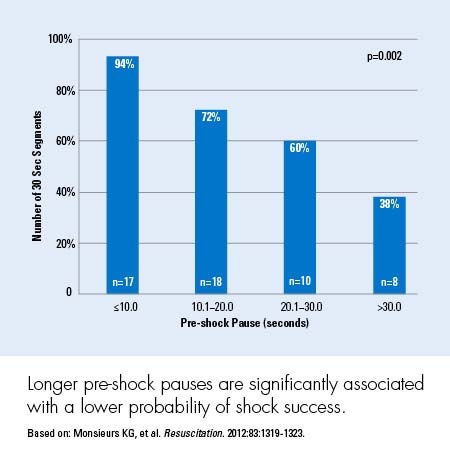

5 However, there is a dramatic variation in the survival rates across various systems of care, with the most successful systems reporting survival rates five times higher than the least successful. Chest compression fraction (CCF) is the cumulative time spent providing chest compressions divided by the total time taken for the entire resuscitation. 4 Emergency systems that can immediately and effectively implement life support measurement can achieve witnessed VF cardiac arrest survival of almost 50%. 3, 4 Cardiac-arrest victims who present with ventricular fibrillation (VF) or pulseless ventricular tachycardia (VT) have a substantially better outcome compared with those who present with asystole or pulseless electrical activity (PEA). 2 In the United States and Canada, approximately 350,000 people/year suffer a cardiac arrest (approximately half of them in-hospital) and receive attempted resuscitation approximately 25% of these present with pulseless ventricular arrhythmias. 1 In- and out-of-the-hospital cardiac arrest remains a substantial public health problem and a leading cause of death in many parts of the world. 58,61,65,119 121 There is some evidence that the use of CPR feedback may be effective in modifying chest compression rates that are too fast. Recommended educational tools include high-quality medical simulators, videos, and written tests accompanied with a performance assessment.Ĭardiac arrest is the abrupt cessation of cardiac pump function which leads to death, but in some cases can be reversible by a prompt intervention in the form of cardiopulmonary resuscitation (CPR). In studies to date, the use of CPR feedback devices has not been shown to significantly improve performance of chest compression depth, chest compression fraction, and ventilation rate. The 2010 AHA guidelines recommend education to improve the effectiveness of resuscitation. Minimizing the interval between stopping chest compressions and delivering a shock improves the chances of shock success and patient survival. The most used measurements are survival to hospital discharge, or neurologically intact survival to discharge.įive main components of high-performance CPR have been identified: chest compression fraction, chest compression rate, chest compression depth, chest recoil, and ventilation.

Identifying the most accurate and relevant post–cardiac arrest outcomes to measure is a major challenge. We will review the studies behind these recommendations. Major changes were made in the 2010 American Heart Association (AHA) guidelines for cardiopulmonary resuscitation (CPR) and emergency cardiovascular care. How do you feel about BLS (and ACLS) training for the average professional.
#CHEST COMPRESSION FRACTION ACLS FREE#
For any inquiries or additional information, please feel free to contact our dedicated team at 87. Invest in Church Group CPR Training today and make a difference in the lives of your congregation members. There is a dramatic variation in the survival rates across various systems of care. Join Attentive Safety in creating a prepared and confident church community. In- and out-of-the-hospital cardiac arrest remains a substantial public health problem and a leading cause of death in many parts of the world.


 0 kommentar(er)
0 kommentar(er)
